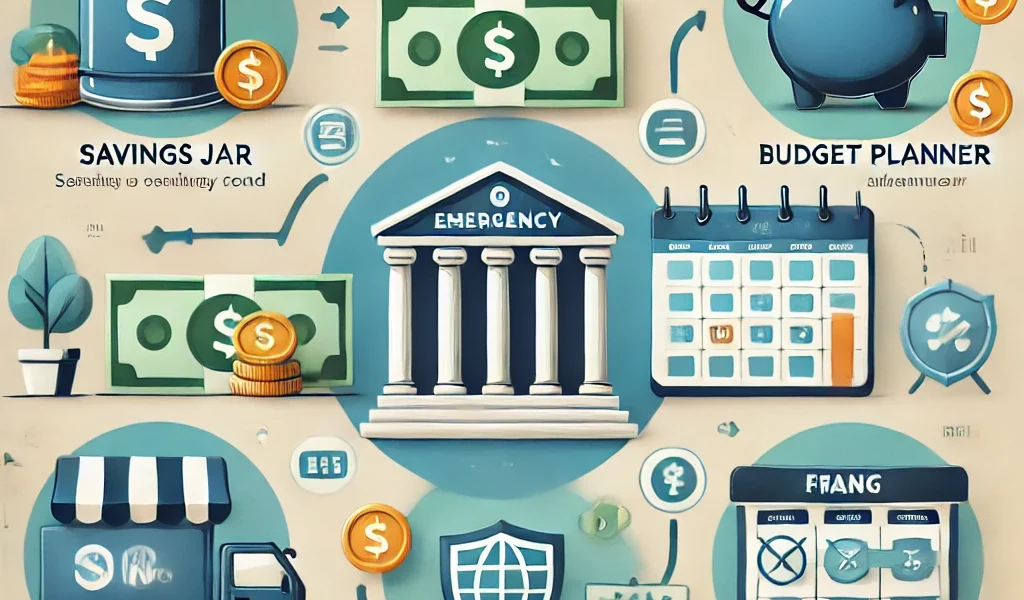Introduction
An emergency fund is a crucial component of financial stability. It acts as a financial safety net, protecting you from unexpected expenses such as medical emergencies, job loss, car repairs, or urgent home maintenance. Without an emergency fund, you may have to rely on credit cards or loans, leading to financial stress and debt accumulation.
This guide provides a step-by-step approach to building an emergency fund effectively, ensuring financial security and peace of mind.
Why an Emergency Fund is Essential
Before diving into how to build an emergency fund, it’s important to understand why it is necessary:
- Prevents Debt Accumulation: An emergency fund eliminates the need to rely on credit cards or loans for unexpected expenses.
- Provides Financial Security: Knowing you have funds available for emergencies reduces stress and financial anxiety.
- Avoids Disruptions to Long-Term Goals: Without an emergency fund, you might have to dip into retirement savings or investments, disrupting long-term financial plans.
- Improves Financial Independence: Having savings in place gives you the flexibility to handle life’s uncertainties without depending on others.
Step 1: Determine Your Emergency Fund Goal
The ideal size of your emergency fund depends on various factors, including income, monthly expenses, job stability, and financial obligations. Generally, financial experts recommend saving three to six months’ worth of essential living expenses.
How to Calculate Your Emergency Fund Goal:
- List your monthly fixed expenses (rent/mortgage, utilities, groceries, insurance, transportation, loan payments, etc.).
- Multiply this amount by three to six, depending on your job security and other personal factors.
- If you have variable income or dependents, consider saving closer to six months’ worth of expenses.
Step 2: Set a Realistic Savings Plan
Once you’ve determined how much you need, set a savings plan to reach your goal.
Tips for Setting a Savings Plan:
- Start Small, Increase Gradually: Begin with what you can afford, even if it’s just $10 or $20 per week.
- Set a Monthly Savings Target: Automate transfers to a dedicated emergency fund account to ensure consistency.
- Use a Budgeting Strategy: Apply the 50/30/20 rule, allocating 20% of your income toward savings and debt repayment.
Step 3: Choose the Right Savings Account
Selecting the right place to store your emergency fund is crucial. The account should be liquid (easily accessible) while offering some level of interest.
Best Options for an Emergency Fund:
- High-Yield Savings Account: Provides easy access and earns interest.
- Money Market Account: Offers higher interest rates with check-writing capabilities.
- Traditional Savings Account: Good for accessibility, though interest rates may be lower.
- Avoid Investment Accounts: Stocks and mutual funds carry risk and are not ideal for emergency funds.
Step 4: Reduce Unnecessary Expenses
Cutting back on discretionary spending helps you save faster.
Ways to Reduce Expenses:
- Cancel unused subscriptions and memberships.
- Cook at home instead of dining out.
- Reduce entertainment expenses, such as streaming services or luxury purchases.
- Negotiate bills, like internet, phone, and insurance.
- Use cashback rewards and discounts for everyday purchases.
Redirect these savings directly into your emergency fund.
Step 5: Automate Your Savings
Automating contributions makes it easier to build your emergency fund consistently.
How to Automate Savings:
- Set up direct deposit to transfer a portion of your paycheck into your savings account.
- Use automatic transfers through your bank to move money regularly into your emergency fund.
- Round-up savings apps help save small amounts automatically with each purchase.
Step 6: Find Additional Income Sources
Increasing your income can speed up emergency fund growth.
Ways to Earn Extra Money:
- Freelance or gig work: Utilize skills like writing, graphic design, or consulting.
- Sell unused items: Declutter and sell items online or at garage sales.
- Take on a side job: Consider part-time work or seasonal jobs.
- Monetize a hobby: If you have a passion for crafts, photography, or tutoring, turn it into a source of income.
Step 7: Use Windfalls Wisely
Unexpected cash inflows can significantly boost your emergency fund.
Sources of Windfalls:
- Work bonuses or raises
- Tax refunds
- Gift money
- Inheritance or settlements
Instead of spending windfalls, allocate a portion to your emergency fund.
Step 8: Keep Your Emergency Fund Separate
To avoid unnecessary spending, keep your emergency savings in a separate account.
Benefits of Separating Your Emergency Fund:
- Prevents temptation to spend it on non-emergencies.
- Provides clear tracking of progress.
- Helps build discipline in saving.
Step 9: Know When to Use Your Emergency Fund
It’s important to use your emergency fund only for genuine emergencies, not for regular expenses or impulse purchases.
Valid Uses for an Emergency Fund:
- Medical emergencies
- Job loss or income reduction
- Urgent car or home repairs
- Unexpected family emergencies
Avoid Using It for:
- Vacations or shopping
- Down payments on a home or car (separate savings needed)
- Regular bills (budgeting should cover these)
Step 10: Replenish Your Fund After Use
If you need to dip into your emergency savings, prioritize rebuilding it as soon as possible.
Ways to Replenish:
- Adjust your budget temporarily to allocate more toward savings.
- Cut back on discretionary spending for a few months.
- Use extra income or windfalls to restore the fund.
Step 11: Monitor and Adjust Regularly
Your financial situation may change over time, requiring adjustments to your emergency fund.
Regular Reviews Help:
- Ensure your fund aligns with your current expenses and lifestyle.
- Adjust savings contributions based on new income levels or financial obligations.
- Reevaluate where you store your emergency fund to maximize returns.
Conclusion
Building an emergency fund is an essential step toward financial security. By setting a realistic savings goal, automating savings, reducing expenses, and being disciplined in fund usage, you can create a reliable safety net for unexpected financial setbacks.
Start small, stay consistent, and watch your financial confidence grow. Having an emergency fund not only prepares you for life’s uncertainties but also empowers you to make better financial decisions without stress. Begin today and take control of your financial future!




